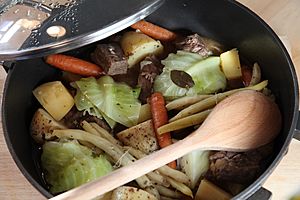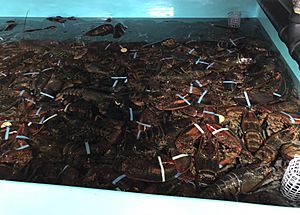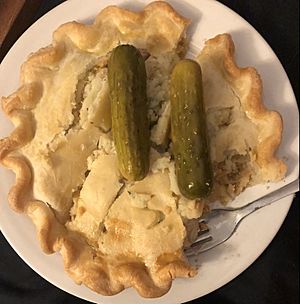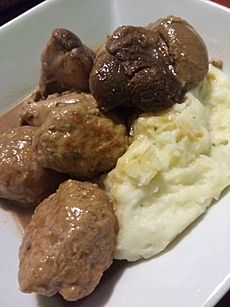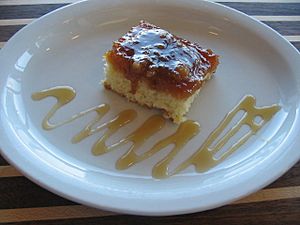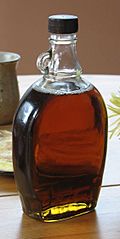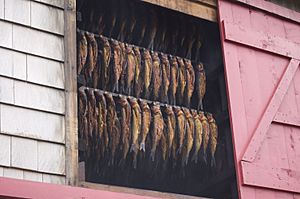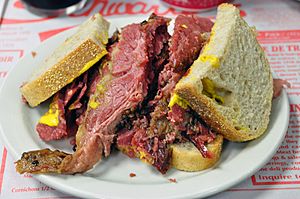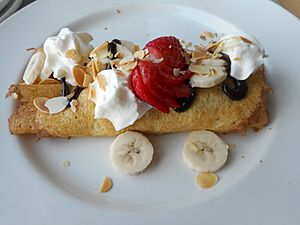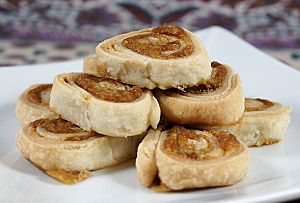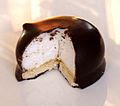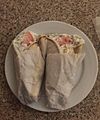Cuisine of Quebec facts for kids
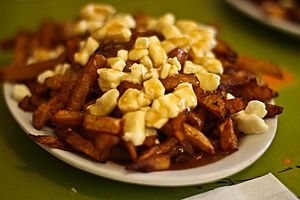
Québec's cuisine is a special way of cooking that comes from French cuisine in the 1500s. It started in New France because life was hard, ingredients changed with the seasons, and people needed to save food. Québec's food has been shaped by its history of fur trading and hunting, cold winters, good soil, lessons from First Nations people, British cuisine, American cuisine, old trade routes, and foods from immigrants.
Québec has many unique dishes. It is most famous for poutine, tourtières, pâté chinois, pea soup, fèves au lard, cretons, and desserts like grands-pères, pouding chômeur, and St. Catherine's taffy.
Québec makes the most maple syrup on the planet. About 72% of the world's maple syrup comes from Québec! The province is also known for creating over 700 different kinds of cheese. Some of these cheeses have even won international awards.
Food expert Jacob Richler said that Québec's food is more unique than food from other parts of Canada. This is because of its different language from the United States and because it had more time to grow. Québec's food is also very similar to Acadian cuisine because they are close and share a language and history.
Contents
History of Québec's Food
Québec's food began with cooking styles from Northern France in the 1500s. It also kept some traditions from the Poitiers region in France. For example, many Québécois make pâté marmite, soupe aux gourganes (a soup with fava beans), and other bean soups. Also, French seafood stews called chaudrées charentaises became quiaudes in Gaspesia. And a dish from Poitiers turned into tourtières.
Other foods that came from France include pot-au-feu (a type of stew), blood sausage (boudin), head cheese (tête fromagée), plorine sausages, ham hock stew (ragoût de pattes de cochon), rabbit stew (civet de lapin), French toast (pain perdu or pain doré), and pastries like crêpes, beignets, croquignole biscuits, and tarts. Just like in France, pork is the most popular meat.
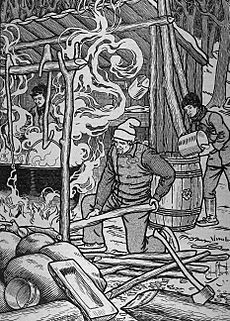
When French settlers arrived in the early 1600s, they loved their own foods. But they also learned cooking skills from the Algonquins, Atikamekw, and Iroquois First Nations. The most important things they learned were how to harvest maple sap and make maple syrup, ice fishing, and how to smoke fish or meat to preserve it.
Saving food was very important in early times because of the long winters and the many trips made by fur traders. So, butter, herbs, and lard were used for flavor and to salt food. Pork and fish were smoked, while other meats and vegetables were kept in vinegar. People still use these methods today, but not usually to survive. Early settlers also hunted and fished for their meals.
By the 1670s, many farmers lived around Quebec City. French eating habits were common. Meals almost always had soup, bread, meat, and wine. Since grapes were hard to grow, wine always came from France.
When the British took over New France in 1760, some food habits changed. One big change was that wine could no longer be imported from France. Another major change was the arrival of the potato. In just a few decades, potatoes became a main food in Québec, taking the place of bread. People also started eating more sugar. The British also brought many recipes like mashed potatoes, crumble, and meat pies.

After a border dispute in 1839, Québec and New England had more contact. Some recipes inspired by this exchange included fèves au lard (baked beans), homemade ketchup, and date squares. Many French Canadians became very poor. This poverty made them simplify their meals. Soups were sometimes just warm water. People rarely drank alcohol, and butter was used very little or not at all. Some foods eaten during hard times, like ploye (a type of pancake), appeared then.
By the early 1900s, things got a bit better, but French Canadians were still poor. Most families often ate a mix of potatoes and pork, which is still a common meal today. During this time, the passenger pigeon, called tourte in French, became extinct. This bird's meat was used in pies called tourtières. So, the tourtière recipe had to change. Farmers started using meats like beef and pork instead.
The Great Depression in the 1930s led to new recipes that were tasty and cheap. These included pâté chinois ("Chinese pie") and pouding chômeur ("unemployed man's pudding"). After this time, more immigrants came from different parts of Europe, not just the British Isles. Jewish foods like bagels and Eastern Europe-style smoked meat became popular. This led to the creation of Montreal-style smoked meat and Montreal-style bagels.
The 1950s brought many changes to how Québécois ate. Many American fast-food companies and restaurants opened in Québec. Raw milk was banned. Many fruits and vegetables became available all year. And Québécois no longer needed to hunt and fish for food. Because of this, the traditional Québécois bread was replaced with sandwich bread. Many old cheese recipes were forgotten, and new ones were created. Foods like spaghetti, pizza, turkey, bacon, sausages, factory-made cheeses, hamburgers, hot dogs, french fries, coleslaw, lobster rolls, and hot chicken all became popular.
These changes led to the creation of poutine, Québec's most famous dish, in the late 1950s. They also helped many Québécois restaurants become popular, such as Lafleur, Valentine, La Belle Province, Chez Ashton, Chez Cora, and St-Hubert.
The Quiet Revolution in the 1960s greatly improved the lives of French Canadians. This allowed them to eat a wider variety of foods and helped create high-quality products in Québec.
From the 1970s until today, different parts of Québec have been making their own special dishes. They also create unique products like ice cider and local wines and cheeses. Many immigrants from Europe have also brought new cooking styles. This has led to even more unique, high-quality cheeses and drinks being made across Québec. It has also brought back interest in traditional local recipes.
Finally, many immigrants from other parts of the world have opened restaurants with their own cuisines. Sometimes, these cooking traditions are mixed with Québécois food.
Ingredients in Québec's Food
Game, Seafood, and Fish
In the past, many families in Québec were poor. They hunted to feed themselves until the 1950s. Tourtières were once filled with the meat of the tourte, or passenger pigeon. These birds were common and easy to hunt. People said they flew in such big groups that a hunter just had to point a gun up to catch one. But by the early 1900s, the passenger pigeon became extinct because of too much hunting and cutting down forests.
After that, families used whatever meat they had, usually from farm animals. So, most modern tourtières are made with beef or pork. Today, eating game is still a tradition, but you can't buy it in grocery stores. When available, Québécois eat meat from moose, deer, hares, ruffed grouse, or waterfowl instead of farm animals. Game is also sometimes given as a gift.
For seafood, lobster and crab are caught in Gaspesia, the Côte-Nord, and the Magdalen Islands. They are then sold to the rest of Québec. Shrimp is often called crevette de Matane after the shrimp factory in Matane. But the shrimp are actually caught in several villages along the Saint Lawrence River. Mussels, oysters, scallops, and whelks (bourgots) are also caught.
Salmon and trout are the most popular fish in Québec. The brook trout is found almost everywhere. Salmon is farmed and can be caught in 118 different rivers. Arctic char is found in nearly 100 lakes. Other fish caught include lake trout, yellow perch, a type of freshwater salmon from Lac Saint-Jean, frostfish from Sainte-Anne-de-la-Pérade, deepwater redfish from Saguenay fjords, capelin (near the coast), brown bullhead, American eel (between Trois-Rivières and Cap-Chat), Atlantic cod (Eastern Québec), Atlantic herring (Eastern Québec), walleye, muskellunge, Northern pike, micropterus, rainbow smelt, Greenland halibut, mackerel, lake sturgeon, and lake whitefish.
Sainte-Anne-de-la-Pérade hosts a famous festival from December to February called La pêche des petits poissons des chenaux. Here, ice fishers catch tomcods. Long ago, hungry French settlers learned ice fishing from the Atikamekw people. This was a special secret that was not shared with other First Nations.
Farm Animals
Pork is the most common meat in Québécois recipes. Beef is also used a lot, but it has become less popular recently. In summer, beef is often used for barbecues. While horse meat is not eaten much, Québec is where it is most commonly eaten in North America.
Pigs in Québec are mostly a mix of different breeds like Duroc, Yorkshire, and American Landrace. Cattle are also a mix of many breeds. The Angus, Charolais, and Limousin are the most common. Even though there are many cattle, Québec imports most of its beef from Western Canada. Its own cattle are mostly used for dairy products. Milk production is mostly from Holstein cows, but Jersey or Brown Swiss cows are also milked. The Canadienne is an old breed of Québécois cattle that was once very common. There are still a few hundred of these cows left in the Charlevoix and Magdalen Islands regions. Their milk is used to make special cheeses.
Poultry (birds like chicken and turkey) is eaten very often in Québec. The most popular types are chicken and turkey. The old Chantecler chicken breed, created in Oka in the early 1900s, is now available again. Turkey is traditionally served at Christmas and Thanksgiving with croutons and sage. Chicken eggs are very popular and mostly used for breakfast and baking. The Estrie region has raised ducks since the early 1900s. Québec is also the only place in Canada that produces foie gras. It is also the largest producer in North America.
Other meats include lamb, veal, and frog legs (from American bullfrogs and leopard frogs).
Spices, Vegetables, and Fruits
Québécois cooks use butter. Salt can be used alone or with herbs for seasoning. Spices common in old recipes are linked to local plants and old trade routes. These include savory, cloves, cinnamon, parsley, thyme, sage, nutmeg, quatres épices (a mix of four spices), and bay leaf. Recently, spices from the boreal forest have appeared in Québec's kitchens. These include green alder pepper, sweetfern, caraway seed, sweetgale, and juniper berry. Chefs are making these new flavors popular in cooking.
Maple syrup is used to sweeten breakfasts, meats, and pastries. Traditional grains are wheat and buckwheat. Their flours are used in sauces and ragoûts (stews). Buckwheat became popular because it grew well on the Canadian Shield.
The most common vegetables in traditional Québécois cooking were those that could be easily saved for winter. They were kept in cool places like root cellars or pickled in jars. These vegetables include potatoes, onions, carrots, beets, squash, legumes, cabbage, turnips, and corn. Today, Québécois also cook with tomatoes, bell peppers, cucumbers, lettuce, asparagus, cauliflower, broccoli, and other newer vegetables. Rhubarb, fiddleheads, and chives are eaten when they are in season. Rhubarb and chives are often grown in backyard gardens, while fiddleheads are found in the wild.
The most popular berries are blueberries, strawberries, raspberries, cherries, cranberries, gadelle, and cloudberries. They are used in jams, jellies, spreads, desserts, juices, and alcoholic drinks. Blackcurrants and blue honeysuckle have recently become available in Québec. Other important fruits are apples, pears, and plums. Apples are especially important because they are used to make cider and are the main focus of le temps des pommes (apple season).
Imported citrus fruits and tropical fruits are also enjoyed today. In the past, they were so expensive that they were only bought for special events or as gifts. It was common to give children an orange for Christmas.
Mushrooms were not common in Québec's traditional cooking for a long time. Today, when mushrooms are used, they are usually the cremini type. In recent years, dedicated cooks have started using local mushroom species in their dishes. Morel and chanterelle mushrooms are becoming more and more popular.
Finally, some ingredients like rice, molasses, raisins, and brown sugar appear in traditional Québécois recipes. This is because of old trade between New France and places like the Antilles and Brazil.
Traditional Recipes
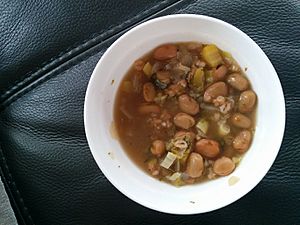
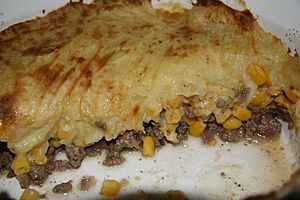
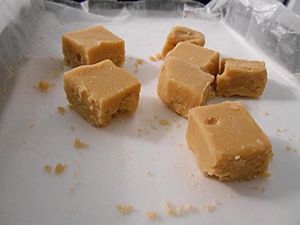
Appetizers
- Cretons—a pork spread with onions and spices.
- Soupe aux gourganes—a soup featuring the traditional gourgane bean.
- Soupe à l'orge perlé—a soup featuring pearl barley.
- Soupe aux pois—a soup featuring peas.
Main Courses
- Chiard—pork stew with potatoes and onions.
- Cigares au chou—ground beef and ketchup cabbage rolls.
- Feuilleté jambon-fromage—rolled pastries with ham and cheese, similar to cinnamon buns.
- Fèves au lard—beans slow-cooked with bacon and maple syrup.
- Galette de sarrasin—a potato pancake.
- Guédille—lobster roll on a hotdog bun, can use other seafood.
- Gibelotte de Sorel—a soup with a tomato base, vegetables, and white fish, from Sorel-Tracy.
- Hot chicken—a chicken sandwich with gravy and peas on top.
- Pâté chinois—a dish with a layer of ground beef, creamed corn, and mashed potatoes on top.
- Pot-au-feu de la récolte—pork or beef pot-au-feu with traditional vegetables.
- Poulet chasseur—floured chicken cooked with vegetables and tomato sauce.
- Poutine—french fries topped with cold cheese curds and hot gravy, Québec's most famous dish.
- Poutine variants—different versions of classic poutine.
- Ragoût de boulettes—a complex meatball ragoût.
- Ragoût de pattes de cochon—a complex ragoût made with pig feet.
- Tête fromagée—a solid dish made from a mix of pork, spices, onions, carrots, and celery.
- Tourtière—a pie usually made with minced pork or beef, a signature dish of Québec.
- Tourtière du Lac-Saint-Jean—a type of tourtière with a thicker crust and cubes of potatoes, meats, and broth.
Desserts
- Beignes—old-fashioned doughnuts.
- Beignes aux patates—potato doughnuts.
- Bonbons aux patates—potato candy.
- Bûche de Noël—a Yule log cake.
- Crumble aux pommes—apple crumble.
- Galette à la mélasse—molasses pancake.
- Gâteau Reine Élisabeth—a cake made with dates, walnuts, and coconut icing.
- Gâteau au pain d'épices—a cake made with certain spices.
- Grands-pères—wrinkly ball-shaped cakes often covered with maple syrup or filled with fruit.
- Pets de sœurs—rolled pastries with a brown sugar filling, similar to cinnamon buns.
- Pouding chômeur—white cake in a maple syrup-based pudding.
- Queue de castor—oval-shaped fried dough with sweet toppings.
- Sucre à la crème—cubes of sugar, condensed milk, and butter, like Scottish tablets.
- Tarte à la farlouche—pie made with raisins, molasses, and brown sugar.
- Tarte au sucre—pie made from a sugar-based filling.
- Tarte au suif—pie made from a sweet beef-fat based filling.
- Tire de la Sainte-Catherine—a sweet taffy, made to celebrate Saint Catherine of Alexandria.
- Tire sur neige—boiling maple sap poured on snow and rolled onto a popsicle stick.
- Trottoir—strawberry or blueberry pie with a criss-cross pattern on top.
Sides
- Betteraves marinées—pickled beets.
- Langue de veau ou de porc—pork or veal tongue.
- Oreilles de crisse—deep-fried salted fatback (pork fat).
Drinks
- Bière d'épinette—spruce beer.
- Cidre glacé—ice cider.
- Vin glacé—ice wine.
- Caribou—a drink made from red wine, a spirit, and maple syrup.
Poutine Variants
Poutine is Québec's most famous dish. It has fresh french fries and fresh cheese curds topped with hot brown gravy in a shallow bowl. The cheese curds are usually at room temperature so they don't melt and stay "squeaky." Poutine first appeared in the Centre-du-Québec area in the late 1950s. No one is completely sure who invented it, as there are a few different stories.
For many years, some English-speaking Canadians didn't like poutine and made fun of it. Some even used it to make fun of Québec's culture. But later, it became a symbol of Québécois culture and the province of Quebec. It has always been linked to Québec's food. Its growing fame has made it popular across Canada, in the northern United States, and around the world. Poutine has even been called "Canada's national dish."
Unique Products
Cheeses
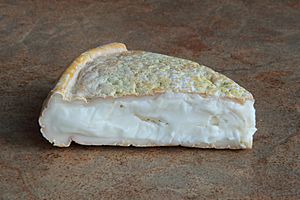
When Canada was part of the French Empire, settlers used their Canadienne cattle to make many soft and semi-soft cheeses. After the British took over New France, they started bringing in hard cheeses like cheddar for people to eat.
In the 1960s, raw milk was banned. This caused most of the old cheese-making methods and recipes, which had been passed down for centuries, to disappear. Only a few recipes remain. The Saint-Pierre cheese, made on île d’Orléans, is the oldest North American cheese. It is a soft cheese sold as La Faisselle, Le Paillasson, or Le Raffiné. Cailles cheese, made from fermented milk and used in salads, was also once very common. Now, it only exists in the Charlevoix and Saguenay-Lac-Saint-Jean regions.
Today, people are trying to find new ways to eat Cailles cheese. Some cheeses were also created by priests. In the late 1800s, a group of Trappist monks came to Oka after being forced to leave France. One of them, from a monastery called Notre-Dame-du-Port-du-Salut, created a special cheese paste. This was used to make the first Oka cheese. Benedictines (another group of monks) created l’Ermite, a blue cheese, in 1943 at Saint-Benoît-du-Lac.
Today, Quebec makes over 700 different kinds of cheeses and is the biggest cheese producer in Canada. People in Quebec enjoy many local and imported hard cheeses, including some flavored with beer or wine. Most soft cheeses are made locally and by hand. Cheese curds are famously used in poutine, one of Québec's most well-known dishes.
Maple Syrup
Quebec produces 72% of the maple syrup sold on Planet Earth and 90% of the maple syrup sold in Canada. Maple syrup is a sweet liquid made from heated maple sap. The syrup is often used at breakfast on crêpes and pain doré. It is also an ingredient in fèves au lard. It can be used to caramelize meats like ham, to balance the taste of some sauces, and as a topping for desserts like pouding-chômeur or Grands-pères au sirop d'érable. Finally, it is the main ingredient used during le temps des sucres (maple sugar season) and at sugar shacks.
Many products are made from maple syrup. Tire, which means sugar on snow, is heated maple syrup poured onto a flat bed of snow. It is then rolled onto a popsicle stick and eaten like candy. Tire is very popular at sugar shacks and in springtime.
Maple butter is a spread often used for breakfast on toast. Maple sugar can replace brown and white sugar. Maple water is not often drunk, but when it is, people usually believe it has health benefits. There are also many maple-flavored products like maple candy and maple drinks.
Boucanage (Smoking Meat)
In Quebec, smoking meat is called boucanage. French Canadian settlers learned this process from Native Americans. While Native Americans only smoked meats, settlers would first soak them in salt water (brine) or add spices before smoking.
Today, places called boucanières or boucaneries specialize in this process. Besides brining and spicing, these places can use different types of wood to add flavor to the meat. Maple wood is the most popular choice. Fish can also be dried before being hung over a fire, which is called boucaner à froid (cold smoking).
This practice has always been popular, especially in the Gaspesia, Bas-Saint-Laurent, and Côte-Nord regions. There, it was useful for preserving fish. Atlantic herrings were historically caught and sold in large amounts, so they were the most smoked. However, trout and salmon caught inland were also commonly smoked.
Smoked salmon has become more popular in recent years because of influences from the United States and Europe.
Pork was also smoked, but the popularity of smoked pork has decreased. Smoked pork is now mostly eaten during Easter. Sometimes it is boiled with its bones beforehand.
In the 1930s, Jewish immigrants came to Montreal and brought some meat smoking traditions from Eastern Europe. One method used Montreal Steak Spice. After the meat is smoked, it is cut into thin slices. This meat is often served in a sandwich with mustard and rye bread.
Cochonailles (Pork Products)
Pork-based cold cuts are traditionally called cochonailles in Quebec. Here are the most popular:
- Creton is made of ground pork, lard (animal fat), milk, and cereal. It is cooked and flavored to make a creamy spread. Cretons are often eaten as a snack or for breakfast on toasted bread, usually with mustard. If another type of meat, like poultry or veal, is used, it is called cretonnade.
- Tête fromagée is less popular but used in the same way as cretons.
- The boudin of Quebec is made of lard, milk, onions, and pork blood. It is often served in a pan with a sweet side or a sauce. Since 2018, an association called Goûte-Boudin de Boucherville gives a yearly prize for the best boudin.
- Plorines (also spelled pleurine or plârine) are made of lard and flavored meat wrapped in pork caul fat. Sometimes plorine recipes can also include eggs, beef, or breadcrumbs.
- Oreilles de Christ are pieces of lard that are deep-fried until they are crispy. They are eaten as a snack or with maple syrup.
Pastries
Many different pastries are made in Quebec. Here are some examples:
- Crêpes are flat and round, made from wheat or buckwheat flour. Québec's crêpes are thicker than those from France, but not as thick as pancakes from English-speaking cultures. They are popular breakfast items. They are often served with maple syrup, brown sugar, or fruits. They can also be served for lunch or dinner.
- Beignes, which look like old-fashioned doughnuts, are rings of dough fried in oil. The middle part of the dough is removed to make the ring. These middle pieces are also cooked and eaten as trou de beigne (doughnut holes). Powdered sugar or icing is often added on top.
- Croquignoles are braided, twisted, or rectangular fried dough pastries. They are a little less popular than beignes and are most often found in rural areas.
- Tartes, similar to pies, have a shortcrust (flaky pastry) outside and a filling inside. The most popular fillings are fruit-based, like blueberry, apple, strawberry, or raspberry. Other popular tartes include tarte au sucre, with a butter and brown sugar filling. Tarte à la farlouche has a mixed brown sugar, molasses, and dried raisins filling. Tarte au suif has a beef fat filling.
- Sucre à la crème is a sweet snack made of cream, brown sugar, and butter. You can sometimes find it sold in convenience stores.
- Pets-de-sœur are made from flattened dough covered in a butter and brown sugar mix. The dough is then rolled up, cut into cylinder shapes, and then into thin slices.
- Chocolatines are small croissants with chocolate inside. They are sometimes sold in corner stores.
- Bûche de Noël is a rolled cake that is traditionally eaten during the holidays.
- Pouding chômeur is a white cake soaked in maple syrup or brown sugar.
- Grands-pères is a type of cake shaped like a ball. It is eaten plain or covered with maple syrup. They can also sometimes be filled with fruits. They are sometimes served as part of meals.
Regional Specialties
Bas-Saint-Laurent
- Matane shrimp
Cantons-de-l'Est
- Duck from Lake Brome
Montréal
Special Plants and Animals
Plant Strains
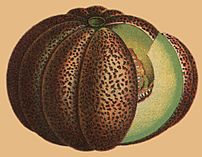
Over many years, special types of fruits and vegetables were created in Quebec. The need to grow these unique Quebec plants has decreased recently, causing most types to be lost. Here are some plant types that have been saved or found again:
- White Canadian corn
- The crotte-d’ours potato of Louis-Marie
- The Thibodeau bean of Saint-Jules
- The pomme Fameuse (a type of apple)
- The Montreal melon
- The Mémé tomato of Beauce
- The potato onion
- Neuville corn
Animal Breeds
Even though there are fewer of them now, these animal breeds created in Quebec are still used today:
- Canadienne cattle
- Charlevoix lamb
- Chantecler chicken
Québec's Food in Media
TV shows about Quebec cuisine include À la di Stasio, L'Effet Vézina, Le Cuisinier rebelle, Curieux Bégin, Les Chefs!, Et que ça saute, Ricardo, and the Zeste channel.
In books, the publishing house Les Éditions Debeur and magazines like Ricardo, je Cuisine, and Caribou focus on this topic.
Internet sites with content about Quebec cuisine include Recettes du Québec, Zeste, Allrecipes, and Chef Cuisto.
Images for kids
-
The Pikauba was created in 2005 in Hébertville.
-
Le Riopelle de l'Isle is a triple-cream cheese named after Jean-Paul Riopelle.
-
Whippet cookies were first produced in Montreal.
-
Apple orchard in Saint-Joseph-du-Lac for ice cider production.
-
Common Thanksgiving decoration items in Quebec.
-
In Quebec, Pepsi is more popular than Coca-Cola.
-
Quiaude made with Greenland halibut.
-
Quebec-style souvlaki pita (like the Nova Scotian donair).
-
This poutine is named after Samuel de Champlain.


